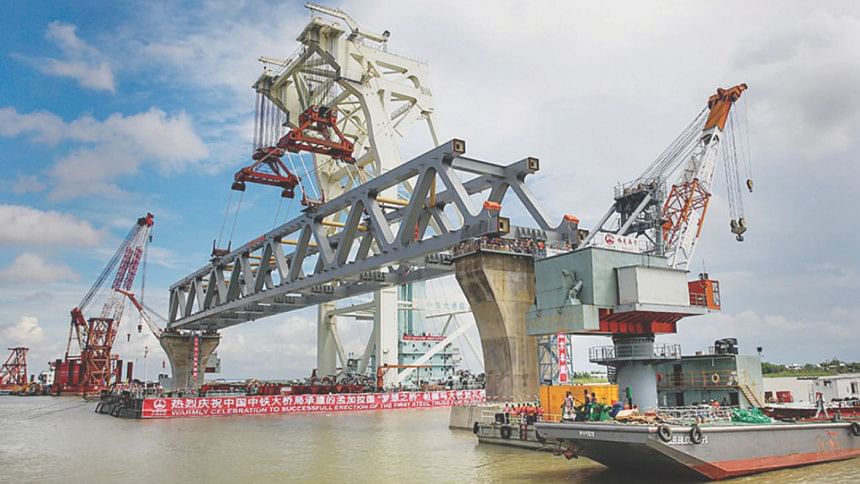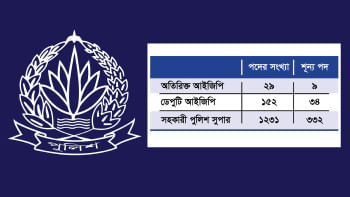Infrastructure spending stimulates growth

Bangladesh has been achieving seven-percent-plus economic growth for the last two consecutive years, averaged at over six percent for over a decade.
Other economic indicators, be it export, import, remittance, domestic consumption and consumer price index, are all in good condition.
Bangladesh's steady economic growth has not gone unnoticed in international circles, at least when judging the developments by the numbers. Many countries including China, Japan, Korea and India have shown keen interest to invest in Bangladesh.
Yet the country's infrastructure remains one of the lowest in quality in the world. Exporters and importers have to spend 15-20 days at the Chittagong port, which facilitates 80 percent of the country's external trade.
The Bangladesh Garment Manufacturers and Exporters Association in July expressed concerns about the poor facility at the premier port.
Exporters also questioned how the port would advance the country's $50 billion RMG production target when it could not handle the export of $28 billion of readymade garment items at present.
The Federation of Bangladesh Chambers of Commerce and Industry, the apex trade body, also raised the issue many times.
Chronic traffic congestion in Dhaka and Chittagong and frequent clogging of highways often reflect the country's poor infrastructure.
Bangladesh ranked 114th out of 138 countries in the World Economic Forum's Infrastructure Competitiveness Report 2016-17.
The World Bank's Doing Business Report 2018, released in November, showed that Bangladesh ranked 177th among 190 economies.
Hope lies in the fact that the government in power for two consecutive terms for the past nine years has taken up many projects to improve the ailing infrastructure.
The mega projects include the Padma bridge, Rooppur Nuclear Power Plant, Payra sea port, coal-fired Matarbari and Rampal power plant, metro rail and liquefied natural gas terminal.
Two more big projects, one for a Padma bridge rail link and another of the Karnaphuli river tunnel, have been undertaken for fast implementation.
Though the Padma bridge's 2018 construction deadline may be missed, work is running in full swing.
A recent report on the project's progress revealed that Tk 6,066 crore had been spent on the main project as of September 30. Nearly half of the centring the main bridge's construction has been completed.
Analysts say once complete, the bridge would reap a lot of benefits for Bangladesh.
Professor Jamilur Reza Choudhury said the benefit-cost ratio of Padma bridge was very high.
“We will be greatly benefited from reduced travel time. And the increased connectivity will help link the backward region with the rest of the country. It will be a great boost for the development of our agriculture and industry in the area,” said Choudhury.
It will also connect the country's second most important port at Mongla and industrial zone in Khulna, the Asian Highway and Trans-Asian Railway.
The government's commitment to develop infrastructure is also evident in increased allocations for development programmes.
The size of the annual development programme rose to Tk 164,000 crore in 2017-18, up sevenfold from Tk 22,500 crore a decade ago.
Bangladesh has also increased infrastructure investment over the years. The amount reached $6 billion in 2016-17 from $2 billion in 2011-12.
This additional spending on infrastructure has been helping allied industries, such as cement and steel, to grow and create employment.
According to auto re-rolling steel millers, Bangladesh has the capacity to produce about 70 lakh tonnes of steel a year but all of the mills managed to churn out 50-55 lakh tonnes of steel in 2017. It was 40-45 lakh tonnes a year ago.
Steel millers said the government's construction activities were the main driver of the growth.
Like steel, the cement industry also witnessed growth in their business in recent years.
Currently, the country's annual demand for cement is nearly 25 million tonnes against a combined effective production capacity of 43 million tonnes.
In spite of the excess capability, several manufacturers have increased their capacity by approximately six million tonnes in 2017, according to industry insiders.
All these activities show that increased spending on infrastructure is driving the growth in other sectors. Still businesses believe that the spending is not enough to take the country to a higher and sustainable growth path.
“Yet, the amount of spending is inadequate compared to the investment made by peer countries,” said Abul Kasem Khan, president of Dhaka Chamber of Commerce and Industry.
According to him, Bangladesh's infrastructure spending stands at only 2.85 percent of the GDP whereas it is 10 percent in Vietnam, nine percent in China and five percent each in India, the Philippines and Sri Lanka.
Khan said if Bangladesh wants to attract foreign direct investment and remain competitive, it would have to raise investment in infrastructure.

 For all latest news, follow The Daily Star's Google News channel.
For all latest news, follow The Daily Star's Google News channel. 



Comments